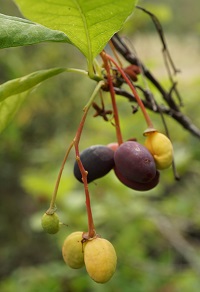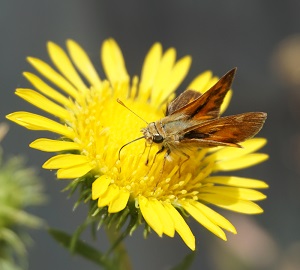CNPS SCV Nursery History
The CNPS SCV Nursery was started in 1995 when Jean Struthers got a $10,000 grant from the Packard Foundation to build a nursery for the chapter. With that grant and the donation of some fencing left over from a Christmas tree lot, the nursery was started at Hidden Villa. The following excerpts starting from the July-August 1995 isssue of the Blazing Star trace the development of the Nursery.
Read more ...
CNPS SCV Nursery

CNPS SCV Nursery
-- founded by Jean and David Struthers
Where ecology and horticulture connect.
The Santa Clara Valley Chapter of CNPS maintains the CNPS SCV Nursery on the grounds of Hidden Villa in Los Altos Hills. Volunteers propagate native plants throughout the year for the chapter's Native Plant Sales. Proceeds from plant sales are the major source of funding for chapter activities. To see what's available, please go to our online store:
https://california-native-plant-society-santa-clara-valley-chapter.square.site/
For more information, contact the Nursery Manager, Vivian Neou at This email address is being protected from spambots. You need JavaScript enabled to view it..
You can learn more about the history of our nursery here.
An illustrated list from Calflora of all the species (this does not include cultivars) grown at the nursery is available here.
Directions: Hidden Villa is located on 26870 Moody Road Los Altos Hills, CA 94022. It is west of Foothill College. From Hwy 280 in Los Altos Hills, take the Moody Road exit and head west. Two miles west of Foothill College, look for the Hidden Villa sign and driveway on the left. Proceed over the bridge, and park in the Dana Center parking lot to your right. Parking is free for volunteers and plant sale customers. The nursery is just beyond the Dana Center. Google Map Link
Open work sessions at our nursery have been canceled indefinitely.
Osmaronia cerasiformis - Oso berry [May 6, 2016]
 Oemleria cerasiformis (Oso berry)
Oemleria cerasiformis (Oso berry)
Family: Rosaceae
Genus: Oemleria
Common names: Oso berry, Indian plum
This underutilized plant can be cultivated as either a shrub or small tree. It grows up to 12 feet tall and 8 feet wide when mature.
It is deciduous but forms bright green leaves in early spring. It develops flowers at the same time, with cascades of small white flowers appearing as soon as February. Bloom can continue for a couple months and is followed by fruit in late spring and early summer.
One of its common names, Indian plum, comes from its fruit, which resemble small plums when ripe. Its fruit is popular with birds making it a great addition to a habitat garden.

This plant is dioecius, which means that male and female flowers bloom on different plants. You must have at least one of each before the female plants will set fruit. Both male and female plants produce flowers, although the male flowers tend to be a bit showier. Some people think the scent of the male flowers is unpleasant, while the female flowers are said to smell like watermelon.
Oso berry prefers loamy soil, but will tolerate clay. In the wild, it is usually found in moist areas, and it will grow more quickly when provided with water. It is able to handle dry conditions once established. It prefers light shade, but can tolerate full sun.
The Life of a CNPS SCV Nursery Plant
When you buy a plant at our nursery, you’re getting the result of a year or more of careful nurturing by our volunteers.
Our plants are grown from both seeds and cuttings, which we obtain from our stock area, commercial growers and CNPS members. We don’t focus on a specific area of the California Floristic Province, so we grow plants for a wide variety of environments from many regions of California – in addition to a wide variety of local natives, we also raise plants from the mountains, deserts and wetlands.
Read more ...
Pollinators and Blooming Beauties [9/16/2015]

What's Blooming in the Nursery
Most of the time, these articles will be about specific plants that we think you would enjoy adding to your garden. But sometimes, we can't resist sharing the wonders that we see as we work in the nursery. This week the Grindelia camporum (Great Valley gumweed) was a pollinator magnet. Skippers, bees and flies (masquerading as bees) were busily feasting.
Of course, the parade of flowers didn't end there. A few of the others on display included:
- Achillea millefolium (common yarrow) - the Island Pink variety was eye-poppingly bright
- Corethrogyne filaginifolia (common sandaster)
- Dendromecon harfordii (bush poppy)
- Diplacus X (hybrid monkeyflower)
- Epilobium canum (California fuschia)- in addition to the usual reds, 'Summer Snow' brings white into the mix
- Ericameria nauseosa (rubber rabbitbrush)
- Eriogonum (buckwheat) - a huge selection of these wonderful summer and fall bloomers continue to put on a show.
- Monardella macrantha (hummingbird monardella)
- Monardella villosa (coyote mint)
Read more ...



 Oemleria cerasiformis (Oso berry)
Oemleria cerasiformis (Oso berry)
